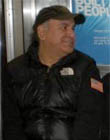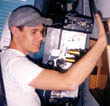|
|
 
|
|
Author
|
Topic: Cue marks on the left side
|
|
|
|
|
|
|
|
|
Randy Stankey
Film God

Posts: 6539
From: Erie, Pennsylvania
Registered: Jun 99
|
 posted 11-02-2002 05:21 PM
posted 11-02-2002 05:21 PM




Depends on where they are within the movie.I have heard a few different stories: 1) When the print gets beat up and the projectionist can't tell HIS cue marks from the last guy's he'll move them to another corner so he can tell. Some guys use a china marker and make an "X" or a slash mark in the picture instead. 2) There are some places that have light, curtain and sound cues. For instance, at the end of the feature there might be a cue in another corner to tell the operator when to fade the lights up or close the curtain. 3) In prints that have been played (or will be played) on telecine/video there may be "take cues" that come before the first frames of the reel for use by the guy at the control board. You'll most often see these on advertisements and not on reels of the feature, though. 4) Some old, foriegn films have cues in different places because (I assume) the placement of cues wasn't standardized at the time.
| IP: Logged
|
|
Frank Angel
Film God

Posts: 5305
From: Brooklyn NY USA
Registered: Dec 1999
|
 posted 11-02-2002 08:22 PM
posted 11-02-2002 08:22 PM





Anyone making indelible emulsion cues in any place but the standard position needs to have their fingers broken. Lab cues, although not exactly invisible to the audience, are at least a solid, static dot. Emulsion scratch cues, even those made with a cue marker have an "animated" look because the cue marker will always have irregularities between each of the marks. Those cues scratched into the emulison without the assistance of a cue marker are even worse -- they dance. To molest a print with permanent emulsion marks to cue curtains or lights or whatever, is nothing short of criminal. All those additional, distracting marks will mar every presentation of that print for the rest of its life. Grease pencil, even though it might be distracting for the one show, at least it can be easily removed, making it infinately more desirable than emulsion scratch cues. When we get older prints that have multiple cues, sometimes even cues on top of cues and all in the wrong frames, we use Letraset black line material to cover then. The line material will even cover those disgusting cues made with hole-punchers. The line material presents a short duration, solid black block on the screen....much less of a distraction than the dancing white circles. When we get prints that have cues in the correct postion but are scratched cues and not lab cues, we cover them with the Letraset black dots, especially in dark scenes or in fade-outs -- there is nothing more obvious than a white scratched cue in a completely black frame. Besides, in a fade-out, there is no need for the change-over cue -- just take the cue when the picture is completely black. On prints that come in without any cues (usually we see this with foreign prints), we make the cues with the dots with a note in the can that explains that the cues can be removed when making up the print for platter use. There is no reason to have any cues at all for platter operation. Since 99% of the prints will ONLY play platers, I would hope that sooner or later the industry would just eliminate cues all together. After all, even lab cues are alien marks in eight frames that could otherwise be pristine. With today's technology, there should be no needed for visible cues. For the few situations where a print will play in a change-over house, let the change-over folks add their removable cues for their run, then remove them so that future engagement can be presented pristine. Frank
| IP: Logged
|
|
Scott Norwood
Film God

Posts: 8146
From: Boston, MA. USA (1774.21 miles northeast of Dallas)
Registered: Jun 99
|
 posted 11-02-2002 11:52 PM
posted 11-02-2002 11:52 PM





I'm going to disagree with Frank here: please don't get rid of the lab cues! I've seen so many bad excuses for cue marks done by theatres without the equipment or time to make them properly. Sadly, not everyone has a sync block and Clint Phare cue marker and instead will use things like hole punchers designed for paper, razor blades, etc.Better to just let the labs make proper cues (which they do more consistantly than theatres) than to let some bozo in the booth screw them up. I have no problem with people adding their own permanent cues to cue-less prints _if_ they do it properly. For those who don't have a proper cue marker, please use grease pencil or something removable and let someone with the proper device do it correctly later. And 99% of prints only run on platters? Maybe for something like Harry Potter, but not for releases which have only a dozen prints or so for circulation in the US; I can pretty much guarantee than _all_ of them will eventually play in changeover houses.
| IP: Logged
|
|
Frank Angel
Film God

Posts: 5305
From: Brooklyn NY USA
Registered: Dec 1999
|
 posted 11-03-2002 10:08 AM
posted 11-03-2002 10:08 AM





Scott,I guess the real question is what change-over booth the print winds up in. I just got a print where the lab cues were perfect but someone decided that they weren't visible enough (perhaps a projectionist who left his glasses home one day) and used the paper punch to "augment" the lab cues. So even lab cues don't guarantee a print won't be abused. In fact, if there are lab cues, the only reason new cues would be made in the field would be because frames were being lost by continued cutting of frames by sloppy print make-up and break-down. But again, I say all this kind of damage -- badly made cues and the accordion fan-fold, multiple splices at the leader joints can only be stopped by the print owner proactively making it clear that damaging prints by these practices will be charged back to the theatre. At the very least it would be good to see a series of "DO NOT" warnings in the cans: "DO NOT make cues other than with professional cue makers like Clint or equiv; NEVER use razor blades or paper punches or any other non-professional device to make cues. If no professional cue maker is available, make cues ONLY with removable grease pencil. DO NOT make cuts on new frames to remove and attach leaders -- only use the existing splice. DO NOT use masking tape anywhere on this print -- only use Artist Tape (Scotch 265 or equiv). Any print damage caused by ignoring these guidelines will be billed back to the theatre." The studios had no problem slapping on FBI warnings on every can they sent out for decades; they should put a little of the same effort to instill the fear of "bill back retribution" for print damage. If a manager came up waving a bill for print damage in his hand yelling, "You scratched big X's on that print of FRIDAY AFTER NEXT and I just got this bill for $500. It's going to come out of your pay check; do that one more time and you're fired." Bet that would be the last time that projectionist scratched X's in a print. I wonder how many commercial change-over houses are left in the country. Add that to the non-commercial houses like our Brooklyn Center Cinema and the Loew's Jersey and I guess it is a sizable amount, but I would hope that change-over houses would have at least marginally capable projectionists in the booth, more so than the multiplexes. Or am I being too optimistic? Frank Loosing lab change-over cues would only work if the change-over houses were run competently.
| IP: Logged
|
|
|
|
|
|
|
|
|
|
|
|
All times are Central (GMT -6:00)
|
|
Powered by Infopop Corporation
UBB.classicTM
6.3.1.2
The Film-Tech Forums are designed for various members related to the cinema industry to express their opinions, viewpoints and testimonials on various products, services and events based upon speculation, personal knowledge and factual information through use, therefore all views represented here allow no liability upon the publishers of this web site and the owners of said views assume no liability for any ill will resulting from these postings. The posts made here are for educational as well as entertainment purposes and as such anyone viewing this portion of the website must accept these views as statements of the author of that opinion
and agrees to release the authors from any and all liability.
|

 Home
Home
 Products
Products
 Store
Store
 Forum
Forum
 Warehouse
Warehouse
 Contact Us
Contact Us




 Printer-friendly view of this topic
Printer-friendly view of this topic







 . Some projectionists just don't think and too many others just don't care.
. Some projectionists just don't think and too many others just don't care.












